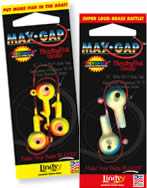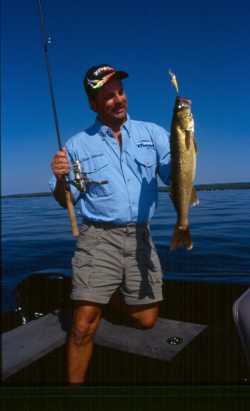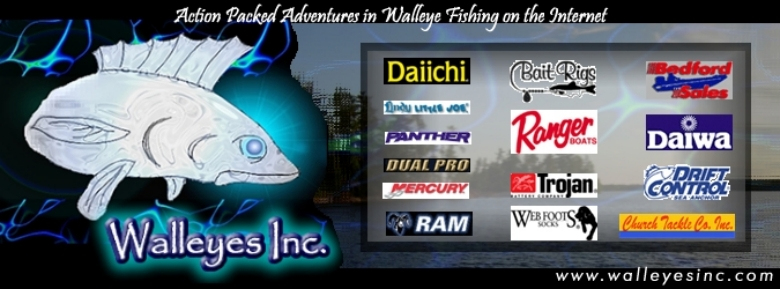|
Most of us aren't as flexible as we used to
be. The days when we could dunk a basketball or do a back
flip are long gone. However, when it comes to fishing, the
opposite is true. Never have we been more dexterous and adroit
than we are today. One of the biggest reasons for our continued
and even growing versatility is soft plastics. There isn't
much we can't do with the variety of plastic products available
today. We can drag 'em, cast 'em, flip 'em, bounce 'em and
troll 'em effectively to catch everything from walleyes and
bass to panfish and pike. Soft plastics are part of my angling
arsenal year-round, but particularly in late summer and through
the fall when a variety of factors challenge even the most
seasoned anglers. While warm water temperatures increase a
fish's metabolism and its need to feed more often, there is
a tremendous quantity and variety of forage available to predator
species. Water clarity is often greater than it has been for
months, and in a lot of cases fish are far more wary and light-sensitive
than they were in earlier in the season. It's a time of year
when it pays to cover water, fish aggressively, fish bulky
baits and choose locations carefully. It's also a time of
year when hot weather can make it challenging to keep live
bait fresh and lively. Soft plastics are often the answer.
The number of ways that soft plastics can be used is limited
only by an angler's imagination.
|

Click
Here for More info
on the Lindy Max Gap Jig
|
Sometimes, it's hard to beat traditional presentations
like a three- or four-inch Berkley Power Grub, Gulp! grub
or the new Lindy Techni-Glo Munchie grub on a long-shanked
Lindy Max-Gap jig. The long shank is an important advantage
when fishing a soft bait aggressively because the hook
is closer to the tail of the plastic where fish are more
likely to get it into their mouth, even when slash-feeding.
Some situations call for more finesse or a closer match
to whatever the preferred forage might be. A lot of bodies
of water, shad are the primary forage. It follows that
deeper-bellied soft baits like Berkley's Power Minnows
are a good choice.In many lakes, leeches make up a good
share of the diet for species like walleye, bass and panfish.
While the real deal is hard to beat, it's also hard to
fish aggressively on a jig head. If an angler tries to
cast them any distance or jig them at all, ribbon leeches
tend to get impaled on the hook where they don't flow
in a natural and tantalizing manner behind the jig. That's
when Berkley's Power Bungee Leeches shine. |
They cast, and they last. On a lot of the western
reservoirs, Berkley's Swimmin' Minnows are the way to go.
They closely resemble the smelt that get caught up and injured
in the turbines at the dams where they make easy meals for
hungry predators. While I'm not ready to declare soft plastic
as a permanent replacement for the real thing, I find myself
expanding my use of plastics every year. Last summer, I was
invited to participate in the Berkley Cup Walleye Challenge,
a one-day contest featuring a number of Professional Walleye
Trail anglers and a group of media representatives. Using
strictly Berkley artificial baits, nearly every boat caught
its share of walleyes, as well as numerous white bass and
other species. The more I work with plastics, the more applications
I find for them. I've caught walleyes on tube tails. I've
knocked 'em dead with 6-inch Berkley Power Nightcrawlers.
I've found situations where jigging worms or ringworms put
fish in my boat when nothing else worked. I've Carolina-rigged
Power Crawlers with success on the tapering points or along
the weedlines in some of the lakes I've fished. It's a great
way to put a bait in the strike zone and keep it there while
inching it down a gradual slope or along a weed edge in search
of walleyes or bass. Texas-rigging plastics is an established
presentation for bass in weeds and lily pads that has its
place in walleye fishing, too.
 |
Shallow fish are typically aggressive fish, and they
find a pulsating plastic crawler hard to resist as it
glides and slides weedlessly through the vegetation. In
most walleye fishing situations, I prefer plastics with
Berkley's Power Bait Tournament Strength Formula for Walleyes
because the only thing better than a bait that looks almost
exactly like the real thing is one that smells like it,
too. When I'm fishing deep or stained water, I've had
good success using plastics on Headlight Lures' fiber
optic line of jig heads that light up a jig for maximum
visibility. There are even a few ways to use plastics
effectively while trolling. On many lakes, spinner rigs
tipped with crawlers and trolled with Off-Shore planer
boards are a favorite presentation of summertime anglers.
However, the areas where we fish these rigs quite often
hold numbers of both white and yellow perch. While that's
what attracts the walleyes, those "nuisance" fish have
a nasty habit of nipping off the tail of a crawler without
giving themselves away, which can lead to unproductive
fishing time. A Power Crawler can be the perfect solution.
Anglers have long appreciated the performance of big plastics
on big jigs as the dropper on three-way rigs, but some
anglers are also using plastics in conjunction with hard
baits. |
Pick a crankbait that dives to the depth you
want to reach and use it as your dropper on the three-way,
then trail it with a plastic grub or crawler on the other
line. Fish that can't pull the trigger on the crankbait will
often whack the trailer. Technology has given us a lot of
tools to work with these days. Soft plastics rank near the
top. Choose them, use them and abuse them. You'll find they
are pliable and reliable.
|

